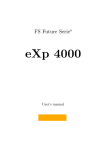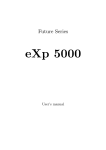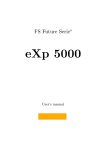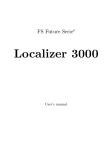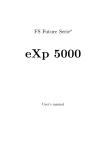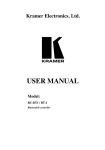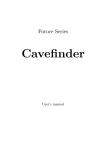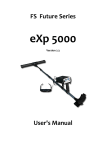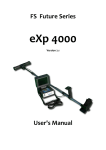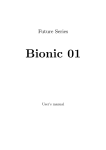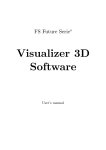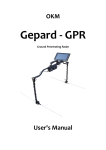Download eXpunhbox voidb@x penalty @M 4000
Transcript
Future Series eXp 4000 8 User’s manual User’s manual: eXp 4000 2 Any information contained in these operating instructions may be changed without prior notice. OKM does not make any warranty for this document. This also applies without limitation to implied assurances of merchantability and fitness for a specific purpose. OKM does not assume any responsability for errors in this manual or for any incidental or consequential damage or loss associated with the delivery, exploitation or usage of this material. This documentation is available as presented“ and without any kind of warranty. In no circumstances OKM ” takes responsibility for lost profits, usage or data losts, interruption of business activities or all kind of other indirectly damages, which developed because of errors in this documentation. This instruction manual and all other stored media, which are delivered with this package should only be used for this product. Program copies are allowed only for security- and savety purposes. The resale of these programs, in original or changed form, is absolutely forbitten. This manual may not be copied, duplicated or translated into another language, neither in part nor completely, over the copyright matters without the prior written consent of OKM. Copyright ©2002 – 2006 OKM Ortungstechnik GmbH. All rights reserved. OKM Ortungstechnik GmbH www.okm-gmbh.de Contents 3 Contents 1 Preface 7 2 Important Notes 2.1 General Notes . . . . . . 2.2 Possible Health Hazards 2.3 Surrounding Area . . . . 2.4 Voltage . . . . . . . . . 2.5 Data safety . . . . . . . . . . . . 8 8 8 8 9 9 3 Technical Specifications 3.1 Control Unit . . . . . . . . . . . . . . . . . . . . . . . . . . . . . . . . . . . . . . 3.2 Data Transmission . . . . . . . . . . . . . . . . . . . . . . . . . . . . . . . . . . . 3.3 Computer, Minimum Requirements . . . . . . . . . . . . . . . . . . . . . . . . . . 10 10 11 11 4 Scope of Delivery 12 5 Assembly 14 6 Installation of Device Driver 16 7 Control Elements 7.1 Front View . . . . . . . . . . . . . . . . . . . . . . . . . . . . . . . . . . . . . . . 7.2 Back View . . . . . . . . . . . . . . . . . . . . . . . . . . . . . . . . . . . . . . . . 19 19 20 8 Operating Modes 8.1 Magnetometer . . . . . . . . 8.2 Ground Scan . . . . . . . . 8.2.1 New Scan . . . . . . 8.2.2 Browse Scans . . . . 8.2.3 Back To Main Menu 8.3 Discrimination . . . . . . . 8.4 Metal Detector . . . . . . . 8.5 Empty Memory . . . . . . . 8.6 Exit . . . . . . . . . . . . . . . . . . . . . . 21 22 23 24 26 27 28 30 31 32 9 Optional Equipment 9.1 Disc Detector Visualization System (DDV) . . . . . . . . . . . . . . . . . . . . . 33 33 10 Discrimination 10.1 Adjust the Discriminator . . . . . . . . . . . . . . . . . . . . . . . . . . . . . . . 10.2 Soil Reconciliation . . . . . . . . . . . . . . . . . . . . . . . . . . . . . . . . . . . 34 34 35 11 Analysis and Evaluation of Measurements 11.1 Metal or Mineralisation . . . . . . . . . . . . . . . . . . . . . . . . . . . . . . . . 11.2 General Procedure . . . . . . . . . . . . . . . . . . . . . . . . . . . . . . . . . . . 11.3 Regulation of the Number of Impulses . . . . . . . . . . . . . . . . . . . . . . . . 36 36 38 39 . . . . . . . . . . . . . . . . . . . . . . . . . . . . . . . . . . . . . . . . . . . . . . . . . . . . . . . . . . . . . . . . . . . . . . . . . . . . . . . . . . . . . . . . . . . . . . . . . . . . . . . . . . . . . . . . . . . . . . . . . . . . . . . . . . . . . . . . . . . . . . . . . . . . . . . . . . . . . . . . . . . . . . . . . . . . . . . . . . OKM Ortungstechnik GmbH www.okm-gmbh.de . . . . . . . . . . . . . . . . . . . . . . . . . . . . . . . . . . . . . . . . . . . . . . . . . . . . . . . . . . . . . . . . . . . . . . . . . . . . . . . . . . . . . . . . . . . . . . . . . . . . . . . . . . . . . . . . . . . . . . . . . . . . . . . . . . . . . . . . . . . . . . . . . . . . . . . . . . . . . . . . . . . . . . . . . . . . . . . . . . . . . . . . . . . . . . . . . . . . . . . . . . . . . . . . . . . . . . . . . . . . . . . . . . . . . . . . . . . . . . User’s manual: eXp 4000 4 12 Danger of Explosion during Excavation 41 13 Error Messages 42 14 Maintenance and Services 45 OKM Ortungstechnik GmbH www.okm-gmbh.de List of Figures 5 List of Figures 1 2 3 4 5 6 7 8 9 10 11 12 13 14 15 16 17 18 19 20 21 22 23 24 25 26 27 28 29 30 31 32 33 34 35 36 37 38 39 40 41 42 43 44 45 Scope of Delivery . . . . . . . . . . . . . . . . . . . . . . . . . . Assembly and Connection of the Probe . . . . . . . . . . . . . . Connection of the External Power Supply . . . . . . . . . . . . Connection of Joystick and Headphones . . . . . . . . . . . . . Connection of the USB Cable . . . . . . . . . . . . . . . . . . . Installation of Device Driver: Step 1 . . . . . . . . . . . . . . . Installation of Device Driver: Step 2 . . . . . . . . . . . . . . . Installation of Device Driver: Step 3 . . . . . . . . . . . . . . . Installation of Device Driver: Step 4 . . . . . . . . . . . . . . . Installation of Device Driver: Step 5 . . . . . . . . . . . . . . . Installation of Device Driver: Step 6 . . . . . . . . . . . . . . . Front View . . . . . . . . . . . . . . . . . . . . . . . . . . . . . Back View . . . . . . . . . . . . . . . . . . . . . . . . . . . . . . Magnetometer: Main Menu, Representation of Values . . . . . Magnetometer: Ground Balance . . . . . . . . . . . . . . . . . Ground Scan . . . . . . . . . . . . . . . . . . . . . . . . . . . . Ground Scan - Submenu . . . . . . . . . . . . . . . . . . . . . . Ground Scan - Parameter . . . . . . . . . . . . . . . . . . . . . Zig-Zag or Parallel . . . . . . . . . . . . . . . . . . . . . . . . . Start first scan line? . . . . . . . . . . . . . . . . . . . . . . . . Graphical Representation of a Measurement in Operating Mode Select Stored Measurement . . . . . . . . . . . . . . . . . . . . Submenu: Browse Scans, Delecte Scan Image . . . . . . . . . . Discrimination . . . . . . . . . . . . . . . . . . . . . . . . . . . Curve Shape of Iron . . . . . . . . . . . . . . . . . . . . . . . . Curve Shape of Precious Metals . . . . . . . . . . . . . . . . . . Curve Shape of Cavities . . . . . . . . . . . . . . . . . . . . . . Metal Detector . . . . . . . . . . . . . . . . . . . . . . . . . . . Empty Memory . . . . . . . . . . . . . . . . . . . . . . . . . . . Exit . . . . . . . . . . . . . . . . . . . . . . . . . . . . . . . . . Control Elements of the Detector . . . . . . . . . . . . . . . . . Adjustment of discrimination . . . . . . . . . . . . . . . . . . . Comparison of object and mineral . . . . . . . . . . . . . . . . Given manner . . . . . . . . . . . . . . . . . . . . . . . . . . . . First measurement of an area . . . . . . . . . . . . . . . . . . . Control scan, Variant A . . . . . . . . . . . . . . . . . . . . . . Control scan, Variant B . . . . . . . . . . . . . . . . . . . . . . Effect of number of impulses and their distance . . . . . . . . . Comparison of small and high number of impulses . . . . . . . Only a small amount of memory available . . . . . . . . . . . . No free memory available . . . . . . . . . . . . . . . . . . . . . Internal Hardware Error . . . . . . . . . . . . . . . . . . . . . . The external power supply has to be charged . . . . . . . . . . Shutting down the system . . . . . . . . . . . . . . . . . . . . . Shutting down the system is not possible . . . . . . . . . . . . . OKM Ortungstechnik GmbH www.okm-gmbh.de . . . . . . . . . . . . . . . . . . . . . . . . . . . . . . . . . . . . . . . . . . . . . . . . . . . . . . . . . . . . . . . . . . . . . . . . . . . . . . . . . . . . . . . . . . . . . . . . . . . . . . . . . . . . . . . . . . . . . . . . . . . . . . . . . . . . . . . . . . . . . . . . . . . . . . . . . . . . . . . . Ground Scan . . . . . . . . . . . . . . . . . . . . . . . . . . . . . . . . . . . . . . . . . . . . . . . . . . . . . . . . . . . . . . . . . . . . . . . . . . . . . . . . . . . . . . . . . . . . . . . . . . . . . . . . . . . . . . . . . . . . . . . . . . . . . . . . . . . . . . . . . . . . . . . . . . . . . . . . . . . . . . . . . . . . . . . . . . . . . . . . . . . . . . . . . . . . . . . . . . . . . . . . . . . . . . . . . . . . . . . . . . . . . . . . . . . . . . . . . . . . . . . . . . . . . . . . . . . . . . . . . . . . . . . . . . . . . . . . . . . . . . . . . . 13 14 14 15 15 16 16 17 17 18 18 19 20 22 22 23 23 24 25 25 26 26 27 28 28 29 29 30 31 32 33 34 37 38 39 39 39 40 40 42 42 43 43 43 44 User’s manual: eXp 4000 46 6 Progress of Data Transmission . . . . . . . . . . . . . . . . . . . . . . . . . . . . 44 List of Tables 1 2 3 4 5 Technical Specifications (Control Unit) . . . . . . . . . . . . . Technical Specifications (Data Transmission) . . . . . . . . . Technical Specifications (Computer, Minimum Requirements) Scope of Delivery . . . . . . . . . . . . . . . . . . . . . . . . . Standard adjustment of the discrimination . . . . . . . . . . . OKM Ortungstechnik GmbH www.okm-gmbh.de . . . . . . . . . . . . . . . . . . . . . . . . . . . . . . . . . . . . . . . . . . . . . . . . . . . . . . . 10 11 11 12 34 1 1 Preface 7 Preface Dear customer, in the first instance we want to thank you that you made your decision on a product of OKM Ortungstechnik GmbH. With the eXp 4000 you purchased a product which is based on a electromagnetic pulse method which can be used to locate anomalies in the target area. Thus the device is able to detect natural features such as formations of strata, cavities, groundwater level as well as sepulchers or buried objects such as pipes, tanks, boxes or suchlike. The eXp 4000 is able to locate, to document and to analyse buried objects with different structures, without making necessary any excavation. Particularly in areas next to the surface there are many advantages to geoelectric, seismic and magnetic procedures and it is further more a usefull complement to these methods. The eXp 4000 has a facile and flexible handling and provides fast and easy reproducible results. With our team of specialists we guarantee that our products are under recurrent control. Our specialists try to implement new developments in terms of further quality improvements for you. Of course by selling our products we cannot guarantee that you really make a find during your research. The recognition of hidden objects and structures depends on a hugh number of factors - like you know. Determining factors are the dielectricity constant of the ground, the grade of mineralisation and the dimensions of an object relating to its depth. Specially in very wet soil, clay and sand with high conductivity of the ground, recording of the measured results can be falsified strongly. With this product you purchased a device which stood the tests in regular operation like all other products of us. If you are interested in where our devices have gone into action please visit our homepage. For our company it is necessary that we protect our developments within the framework of existing legislation to a patent or trademark registration. Therewith we offer you a higher warranty while using our products. Please take your time consecutively, read this user‘s manual and familiarize yourself with the utilisation and operation of this eXp 4000. OKM Ortungstechnik GmbH www.okm-gmbh.de User’s manual: eXp 4000 2 8 Important Notes Please read these operating instructions carefully and closely before using eXp 4000 and its accessories! These instructions give information on how to use the device and point out potential sources of danger. eXp 4000 and its accessories serves for documentation and analysis of detect objects deposited and changes performed in the ground. The registered data of the ground structure will be transmitted to a PC for visual representation in a special software program using the components we offer. Any additional notes relating to this has to be observed. Please read attentively the manual according to the software you are using! 2.1 General Notes Being an electronic device, eXp 4000 has to be treated with the caution and care necessary when such devices are used. Any failure to observe the safety precautions given or any use for purposes other than the ones it is conceived for may result in a damage or destruction of the processing unit and connected components. The device will get destroyed if it is opened improperly. 2.2 Possible Health Hazards If used properly the device normally does not pose any health hazards. According to current scientific knowledge, the high-frequency signals are not harmful to the human body on account of their low power. 2.3 Surrounding Area Having been transferred from a cold to a warmer place, the device should not be operated immediately afterwards. Any condensation, which may have formed, might cause the device to get destroyed. Avoid strong magnetic fields, which may occur in places such as near machines or loudspeakers, and avoid using a detector within a radius of 50 meters. Metallic objects on the ground such as cans, doses, catches, nails, screw or others can influence negatively your measurement and have to be removed. Also you have to remove keys, telephones, chains and rings and all other magnetic and metallic objects from yourself. OKM Ortungstechnik GmbH www.okm-gmbh.de 2 Important Notes 2.4 9 Voltage The power supply should not be outside the indicated range of values. Use only chargers, batteries and rechargable batteries which are included in the scope of delivery. Never use the 230 Volt mains supply. 2.5 Data safety There can be errors in the process of data collection if the range of the sender module is been exceeded, the power supply of the device is to low, the cables you are using are to long, other electronic devices sends out disturbances or atmospherics occurs (lightnings, . . . ). OKM Ortungstechnik GmbH www.okm-gmbh.de User’s manual: eXp 4000 3 10 Technical Specifications The following technical indications are medial values. During operation small variations are quite possible. 3.1 Control Unit Dimensions (H x W x D) . . . . . . . . . . . . . . . . . . . . . . . . . . . . . . . . . . . 430mm x 150mm x 260mm Weight . . . . . . . . . . . . . . . . . . . . . . . . . . . . . . . . . . . . . . . . . . . . . . . . . . . . . . . . . . . . . . . . . . . . . . about 3kg Voltage . . . . . . . . . . . . . . . . . . . . . . . . . . . . . . . . . . . . . . . . . . . . . . . . . . . . . . . . . . . . . . . . . 9.6 - 14.4 VDC 22W maximum Safety Class . . . . . . . . . . . . . . . . . . . . . . . . . . . . . . . . . . . . . . . . . . . . . . . . . . . . . . . . . . . . . . . . . . . . . . . IP40 Operating Time (Full Charged Battery, Delivered Power Supply, 25) Operating Temperature Display . . . . . . . . . . . . . . . . . . . . . about 3 hours . . . . . . . . . . . . . . . . . . . . . . . . . . . . . . . . . . . . . . . . . . . . . . . . . . . . . 0 - 40 . . . . . . . . . . . . . . . . . . . . . . . . . . . . . . . . . . . . . . . . . . . . . . . . . . . 300mcd Background lighting 6.4” Diagonale 640 x 480 Pixel TFT Color Computer . . . . . . . . . . . . . . . . . . . . . . . . . . . . . . . . . . . . . . . . . . . . . . . . . . . . . . . . . . 300 MHz Processor INTEL i586- compatible Working Memory Data Memory . . . . . . . . . . . . . . . . . . . . . . . . . . . . . . . . . . . . . . . . . . . . . . . . . . . . . . . . 128 MB RAM . . . . . . . . . . . . . . . . . . . . . . . . . . . . . . . . . . . . . . . . . . . . . . . . . . . . . . . . . . . . . . . . . . 128 MB Feedback . . . . . . . . . . . . . . . . . . . . . . . . . . . . . . . . . . . . . . . . . . . . . . . . . . . . . . . . . . . . . . . accustic, visual Controller . . . . . . . . . . . . . . . . . . . . . . . . . . . . . . . . . . . . . . . . . . . . . . . . . . . . . . . . . . . . . Motorola 4 MHz Penetration Depth Operating Mode Magnetometer . . . . . . . . . . . . . . . . . . . . . about 2 meters1 Penetration Depth Operating Mode Ground Scan . . . . . . . . . . . . . . . . . . . . . about 25 meters1 Penetration Depth Operating Mode Discrimination . . . . . . . . . . . . . . . . . . . about 25 meters1 Penetration Depth Operating Mode Metal Detector . . . . . . . . . . . . . . . . . . . . about 2 meters1 Table 1: Technical Specifications (Control Unit) 1 depends on object size and ground conditions OKM Ortungstechnik GmbH www.okm-gmbh.de 3 Technical Specifications 3.2 11 Data Transmission Technology . . . . . . . . . . . . . . . . . . . . . . . . . . . . . . . . . . . . . . . . . . . . . . . . . . . . . . . . . . . . . . . . . . . . . . . USB Maximal Data Transmission Rate . . . . . . . . . . . . . . . . . . . . . . . . . . . . . . . . . . . . . . . . . . 19200 Baud Table 2: Technical Specifications (Data Transmission) 3.3 Computer, Minimum Requirements The computer is not part of the scope of delivery. The indicated values should help you for a correct selection of a suitable computer for analysis of your measured results. CD-ROM Drive . . . . . . . . . . . . . . . . . . . . . . . . . . . . . . . . . . . . . . . . . . . . . . . . . . . . . . . . . . . minimum 4x COM-Port (Data Transmission) Free Memory . . . . . . . . . . . . . . . . . . . . . . . . . . . . . . . . . . . . . . . . . . . . . . . . . . . . . . . . . minimum 20 MB Working Memory (RAM) Graphic Card . . . . . . . . . . . . . . . . . . . . . . . . . . . . . . . . . . . . . . . . . . . . . . . . . . . USB . . . . . . . . . . . . . . . . . . . . . . . . . . . . . . . . . . . . . . . . . . . . minimum 128 MB . . . . . . . . . . . . . . . . . . . . . . . . . . . . . . . . . . . minimum 64 MB, OpenGL-compatible Operating System . . . . . . . . . . . . . . . . . . . . . . . . . . . . . . . . . . . . . . . Windows 98SE, Me, 2000, XP Table 3: Technical Specifications (Computer, Minimum Requirements) OKM Ortungstechnik GmbH www.okm-gmbh.de User’s manual: eXp 4000 4 12 Scope of Delivery In the following section you can find all standard equipment. The scope of delivery can be different in some circumstances because of some optional accessories which should not be included in the basic equipment. 1 Control Unit 1 Linkage for Antenna 1 External Power Supply 1 Charger for External Power Supply 1 Cable for External Power Supply 1 Horizontal Probe (25cm) 1 Headphones 1 Joystick 1 User‘s Manual 1 Carrying Case 1 3D Software (Visualizer 3D) [optional] 1 USB-Connection Cable [optional] 1 Horizontal Probe (50cm) [optional] 1 Horizontal Probe (75cm) [optional] 1 Horizontal Probe (100cm) [optional] 1 Antenna for Tunnel Detection (50cm) [optional] 1 Super Sensor (100cm) [optional] 1 DDV System [optional] Table 4: Scope of Delivery Beware that pictures in this manual could be different to delivered parts. OKM Ortungstechnik GmbH www.okm-gmbh.de 4 Scope of Delivery 13 Horizontal- and Vertical Probes Control Unit Linkage for Probe DDV System Headphones USB-Connection Cable Charger for External Power Supply External Power Supply including Cable Joystick Figure 1: Scope of Delivery OKM Ortungstechnik GmbH www.okm-gmbh.de User’s manual: eXp 4000 5 14 Assembly In this section is explained how to assemble the device and how to prepare a measurement. Figure 2: Assembly and Connection of the Probe Figure 2 shows how to assemble the standard horizontal probe (25cm) to the linkage. Therefore just put the probe into the appropriate attachment of the linkage. Then connect the probe cable to the control unit. Do it without any unnecessary application of force! The verticale probes can be used without linkage. You can simply hold it in your hand perpendicularly to the soil. Figure 3: Connection of the External Power Supply Figure 4 shows how to connect the external power supply to the control unit. The cable is placed inside a storage case on the back side of the battery and is wired to this power supply. While connecting the external power supply take care to connect at first the cable with the control unit. The external power supply has to be powered on afterwards. OKM Ortungstechnik GmbH www.okm-gmbh.de 5 Assembly 15 Figure 4: Connection of Joystick and Headphones Figure 4 indicates which connection has to be used for joystick and headphones. Please take care not to exchange both elements, otherwise the device can get damaged. Figure 5: Connection of the USB Cable Figure 5 shows how to plug in the USB connection cable to the computer. Further information about the use and installation of the USB driver you can find in section 6 on page 16. OKM Ortungstechnik GmbH www.okm-gmbh.de User’s manual: eXp 4000 6 16 Installation of Device Driver Before you can transfer data from the device to your computer you have to install the USB driver. Therefore you have to connect the active computer and the control unit via the USB connection cable. When you switch on the power supply a message like in figure 6 will appear on your computer screen. Figure 6: Installation of Device Driver: Step 1 If you prosecute Windows XP with Service Pack 2, you will be asked in dialog from figure 7 if Windows Update has to search for drivers up to date. Mark entry No, not this time and click on Next. Figure 7: Installation of Device Driver: Step 2 In other versions of the operating system Windows this dialog window should not appear. OKM Ortungstechnik GmbH www.okm-gmbh.de 6 Installation of Device Driver 17 In the following dialog window like figure 8 select the entry Install software from a list . . . and click on button Next. Figure 8: Installation of Device Driver: Step 3 In the next dialog window from figure 9 mark the entry No search, select driver individually and click on Next. Figure 9: Installation of Device Driver: Step 4 Another window will open, represented in figure 10, where you have to select the driver file. Therefore click on Data carrier. . . . Immediately another window appears where you click on the button Search. . . . Then select the file OKM_LE.INF, which you can find in the directory \drivers\usb_cable of your software CD. Afterwards you have to click on Open, OK and Next, to start the installation of the files. OKM Ortungstechnik GmbH www.okm-gmbh.de User’s manual: eXp 4000 18 Figure 10: Installation of Device Driver: Step 5 After successful installation of the driver a message like in figure 11 will appear on your computer screen. Now the drivers of your device are installed and you can transfer data to your PC. Figure 11: Installation of Device Driver: Step 6 OKM Ortungstechnik GmbH www.okm-gmbh.de 7 Control Elements 7 19 Control Elements In this section you will learn more about the fundamental use of all control elements for this measuring instrument. All connections, inputs and outputs are explained in detail. 7.1 Front View Figure 12 shows the front side of the control unit. Power On and Off Button Previous Operating Mode Activate Operating Mode Start Button Input for Joystick Next Operating Mode Figure 12: Front View The Power On and Off Button is used to switch on and off the control unit. Before operating with your device you have to connect your external power supply and power it on. The Start Button is used to start a measurement and to to release every impulse manually in the appropriate operating mode. The Input for Joystick is used to connect the delivered joystick to the device. He fullfils the same functions like the Start Button, but is more comfortable and can facilitate the measurement procedure. With the keys tion press and you can select every single operating mode. To confirm your selec- . OKM Ortungstechnik GmbH www.okm-gmbh.de User’s manual: eXp 4000 7.2 20 Back View Figure 13 shows the back side of the control unit with all their connections. Connection of Power Supply USB Connection Connection of Probe Connection of Headphones Figure 13: Back View The Connection of Power Supply is used to connect the device with the delivered battery. Here the external power supply (Power Tank) has to be connected. In the Connection of Probe the cable of the probe has to be plugged in. In the Connection of Headphones the delivered headphones has to be connected to the device. Via the USB Connection the device will be connected to a computer with a USB data cable. OKM Ortungstechnik GmbH www.okm-gmbh.de 8 8 Operating Modes 21 Operating Modes In this section you will learn more about the different operating modes of the device. Every function is been explained in particulary in its proper subsection. The right selection of an operating mode depends primarily of your planned measurement. So for example there are some special functions which have to be used for a first measurement in a unknown area to get a general overview, against which others are more suitable for a detailed search and analysis with a special processing software program. The device proccesses the following operating modes: Magnetometer Research of an area with the integrated magnetometer. Ground Scan Measurement with graphical evaluation, whereby measured data are stored in the internal memory of the device. Discrimination Examination of detected objects regarding to their characteristics on iron contents. Metal Detector Activate optional DDV system to discriminate between metals. Empty Memory Delete all data stored in the internal memory. Exit Power off the device and shut down the integrated PC module. Via a touchpad on the front of your device you can select and confirm your appropriate operating mode. OKM Ortungstechnik GmbH www.okm-gmbh.de User’s manual: eXp 4000 8.1 22 Magnetometer You select operating mode Magnetometer in the main menu to determine the subsoil taking the earth magnetic field into account. Also you can recognize through the graphical representation of a oscilloscope like picture on the monitor if you are placed above an metallic object. Figure 14: Magnetometer: Main Menu, Representation of Values This mode can be used with all antennas except the DDV system. As soon as you confirm the operating mode Magnetometer the integrated magnetometer will be adjusted to the current basic ground value of the place where it is situated in this moment. During the initialization process the message Ground Balance, Please Wait appears on the display. Only if this message disappears you can start your research. Figure 15: Magnetometer: Ground Balance If you power on the device above neutral ground all metals will be shown with a deflection to the top in your monitor. If the device is situated above a metal while activating the magnetometer, all equivalent metal parts will not be recognized. By a new press on the button Activate Operating Mode, you can initiate a manual soil reconciliation. Therefore you have to start on a place with neutral ground. With buttons Previous Operating Mode or Next Operating Mode you are leaving the magnetometer mode and turn back to the main menu. OKM Ortungstechnik GmbH www.okm-gmbh.de 8 Operating Modes 8.2 23 Ground Scan This operating mode allows you to do a measurement with graphical representation whereby all measured values will be stored in the internal memory of the device. Also you have the possibility to recall and see previous stored graphics. This mode can be used with all antennas except the DDV system. Figure 16: Ground Scan In the first submenu which is represented in figure 17, you can choose between the following alternatives: New Scan Set up and record a new graphic. Browse Scans See all stored graphics. Back To Main Menu Finish Ground Scan and go back to the main menu. Figure 17: Ground Scan - Submenu OKM Ortungstechnik GmbH www.okm-gmbh.de User’s manual: eXp 4000 8.2.1 24 New Scan After activating this operating mode you have the possibility to adjust certain settings. There are different parameters which influence the measurement. In figure 18 you can see the corresponding submenu. Figure 18: Ground Scan - Parameter You can modify the following parameters (the underlined values correspond to the setting made by the factory): Impulses (Auto, 10, 20, . . . , 50) Number of measured values per search line. If you select Auto the number of impulses can be adapted to the current length of your search line. During the first line the device will read values regulary without stopping. When you want to finish your first line you have to press the key Activate Operating Mode, to stop the measuring process of the current line. The device will store the number of impulses and use it for all further scan lines of this measurement. By selecting the value 10, 20, . . . or 50 you can preset the number of impulses you need in one measured line. How to select the right number of impulses you can read in section 11.3 on page 39! Impulse Mode (Automatic, Manual) If you are working in mode Manual the measured values will only be recorded when using the Emitter of Impulses. If you select mode Automatic, the measured values will be recorded and represented continuously. Scan Mode (Zig-Zag, Parallel) Scan Mode defines the method of scanning an area. In mode Parallel measurement starts always from the starting line, whereas in mode ZigZag measurement starts at the end of the line which was scanned before, like represented in figure 19. In the last scanning method you have to take care not to change the orientation of the antenna, which means if the white arrow on the side of the probe shows to OKM Ortungstechnik GmbH www.okm-gmbh.de 8 Operating Modes 25 Figure 19: Zig-Zag or Parallel north direction for example it has to show to north direction in every measured line. Select the parameter, which you want to change with the keys Previous Operating Mode and Next until it is highlighted in red color. Now press the key Activate Operating Mode. The marking will change, so that only the current value is highlighted in red color. Now you can change the value of the selected parameter by using the keys Previous Operating Mode and Next Operating Mode. To finish this process you have to press again the key Activate Operating Mode. Operating Mode, Go to your start position and adjust all necessary parameters to your needs. Then you have to select option Start Scanning, to start the measurement. The message from figure 20 will appear and ask you if you want to start your first measure line now. Figure 20: Start first scan line? While using the keys Previous Operating Mode and Next Operating Mode select option Yes, if you want to start the measurement. Confirm your selection by pressing the key Activate Operating Mode. While the device is now sending out the impulses regularly you have to walk continiously your first measured line. As soon as your first scan line is finished a new message will appear, where you have to select Yes if you want to scan another measured line. Repeat this procedure until you scanned your complete area. Step by step a graphical representation similiar to figure 21 will built up. OKM Ortungstechnik GmbH www.okm-gmbh.de User’s manual: eXp 4000 26 Figure 21: Graphical Representation of a Measurement in Operating Mode Ground Scan The graphic should represent green color values in majority, which represent normal ground. In this green area red and blue objects can be placed. Metallic objects are normally represented in red and cavities, water reserves and earth interferences in blue color. Beware that mineralisations of the ground are also shown in red color. How you can differentiate minerals and mineralisations from real“ metals, you can read in section 11.1 on page 36 or in the manual of ” your software program. It is absolutely necessary to read section 11.2 on page 38, where the principle procedure of a graphical measurement is described. 8.2.2 Browse Scans After confirming menu option Browse Scans with the key Activate Operating Mode you will see a list of all stored measurements, like represented in figure 22. Figure 22: Select Stored Measurement Select the measurement which you like to see with the keys Previous Operating Mode and Next Operating Mode. OKM Ortungstechnik GmbH www.okm-gmbh.de 8 Operating Modes 27 Figure 23: Submenu: Browse Scans, Delecte Scan Image For the selected measurement the following options represented in figure 23 are provided. View Scan Image The selected measurement will be displayed once again. Press any key to go back to the selection menu. Delete Scan Image The current selected measurement will be deleted, if you confirm the following message with Yes. Following you will go back to the menu Ground Scan. Cancel You go back to menu Ground Scan. 8.2.3 Back To Main Menu You go back to menu Main Menu. OKM Ortungstechnik GmbH www.okm-gmbh.de User’s manual: eXp 4000 8.3 28 Discrimination This operating mode is used to identify metals and cavities. Therefore it is necessary to connect the optional available super sensor or the antenna for tunnel detection. There is no given manner fixed or a scan direction. You can walk as you want to determine the soil. This operating mode is most effective if you already detected possible objects and now want to know more details about them. Figure 24: Discrimination During the measurement you will get a live picture on the screen of your device. The different curves give conclusion to the characteristics of possible objects. Figure 25: Curve Shape of Iron Figure 25 shows which principle curve shape is created if you pass above an iron object. Typically is the high deflection to the top followed by the same deflection down. OKM Ortungstechnik GmbH www.okm-gmbh.de 8 Operating Modes 29 Figure 26: Curve Shape of Precious Metals Figure 26 shows which principle curve shape is created if you pass above a precious metal. Typically is the small additional deflection with the difference that there is no deflection down. Figure 27: Curve Shape of Cavities Figure 27 shows the principle curve shape when passing over a cavity. Typically is the high deflection down. But there is no equivalent deflection in the opposite direction. OKM Ortungstechnik GmbH www.okm-gmbh.de User’s manual: eXp 4000 8.4 30 Metal Detector To use this operating mode you have to connect the optional DDV system at first. The detector is specialized to find small objects (e.g. coins) which are located near to the surface. Figure 28: Metal Detector Also with the detector you have the possibility to determine the material of possible objects. So for example you can find out if an object consists of gold, silver or iron. Further information about the correct usage of the detector and the principle of discrimination you can find in section 9.1 on page 33 and in section 10 on page 34 of this users manual! OKM Ortungstechnik GmbH www.okm-gmbh.de 8 Operating Modes 8.5 31 Empty Memory The operating mode Empty Memory is used to delete all data which are stored in the internal memory of the device. If you confirm this option you will be asked again if you really want to delete all data. If you confirm now by pressing Yes all data will be deleted and cannot be rebuilt or transferred to a computer. Figure 29: Empty Memory OKM Ortungstechnik GmbH www.okm-gmbh.de User’s manual: eXp 4000 8.6 32 Exit You have to select option Exit, to finish the operation with this device. As soon as you confirmed this selection the integrated pc module will shut down and the device will power off itself. Figure 30: Exit Please wait until the device has powered off itself. After the device is switched off you can power off the external power supply. OKM Ortungstechnik GmbH www.okm-gmbh.de 9 Optional Equipment 9 33 Optional Equipment Here you can find additional information about all equipments which are available as optional accessories to the basic package. 9.1 Disc Detector Visualization System (DDV) With the DDV a powerful metal detector is on your disposal, which not only supports your underground research with a visual representation but also offers you various filter possibilities. A B E C D F A Sensibility Regulator B Operating Lamp C Discriminator D Connector E Retaining Handle F Coil Figure 31: Control Elements of the Detector To use the detector just plug in the connector D into the Connection for Probe of the control unit. Then select the operating mode Detector in the main menu. Attention: As soon as you confirm this option the soil reconciliation will start. Detailed information you can find in section 10 on page 34! Now you have to pivot the detector coil continiously right above the ground, trying to keep the same distance to the soil. Adopt the rhythm of the graphical representation on the screen. As soon as you pass above a metallic object a yellow colored trace will appear in your graphic and you can hear an acoustical sound through the headphones. OKM Ortungstechnik GmbH www.okm-gmbh.de User’s manual: eXp 4000 10 34 Discrimination In this section the regulation of the discrimination and the soil reconciliation is explained. 10.1 Adjust the Discriminator The discriminator serves to filter certain materials. So it is possible to exclude“for example ” worthless iron and steel objects. Or people who are hunting for treasures and gold are able to exclude other materials with the help of this discriminator. Figure 32: Adjustment of discrimination In figure 32 the regulator to adjust the discrimination is represented. This regulator can filter certain materials. Table 5 explains the adjustment in the case of normal ground conditions1 . Adjustment Indicated materials 0 All metalic objects 3 Iron, gold, bronze, silver, aluminium 5 Gold, bronze, silver, aluminium 7 Silver, aluminium 10 Aluminium Table 5: Standard adjustment of the discrimination Beware: When you adjust the regulator for discrimination on gold, the detector reacts besides gold also on bronze, silver and aluminium. To find out if there is really gold in the ground you have to follow the following instructions: 1. Switch the regulator on gold and start your soil examinations until you reach a place where the detector reacts positive. 2. Now switch the discriminator on silver and examine this place again. Following there will be two possibilities: the detector reacts positive → the material under the ground is not gold, but could be silver or aluminium. 1 The indications from table5 concern the use in normal type of soil. In extreme conditions (mineralisation, salt deposits, . . . ) they can variate from this normal value. OKM Ortungstechnik GmbH www.okm-gmbh.de 10 Discrimination 35 the detector does not react → there is probably golden material in the ground but also bronze is possible. Please consider that you always should do the soil reconciliation, which is explained in this following section. 10.2 Soil Reconciliation A correct soil reconcilation is absolutely necessary that the adjusted discrimination can work properly. If the soil reconciliation is not done correctly the operation of the device and the integrated discriminator cannot work properly. In the following section you can find a list of all necessary working procedures to do a correct soil reconciliation: 1. Power on the device and wait until the acoustic signal disappears. 2. Adjust the discriminator on the material you like, see previous section. 3. Put the device with coil probe about 5cm above the ground. 4. Select the operating mode you like and confirm. If you hear an acoustic signal from the metal detector after these indications, then the soil reconcilation is not finished correctly. Repeat these steps until there is no acoustic signal from the metal detector. The following causes can prevent a correct soil reconciliation: You are staying above a metalic object. You confirm the operating mode with integrated discriminator without holding the probe directly above the ground. You are holding the probe during your confirmation of the operating mode with integrated discriminator to high and then minimize the distance to the ground. You are turning the regulator for discrimination during soil reconciliation. Only if you are doing a correct soil reconciliation the functionality of discrimination can be guaranteed. OKM Ortungstechnik GmbH www.okm-gmbh.de User’s manual: eXp 4000 11 36 Analysis and Evaluation of Measurements Before measurement you have to know what kind of objects or cavities you are looking for and if the area you choose is suitable for this. Measurement without a plan will not give you the results you would like. For this reason please consider the following indications: What are you looking for (graves, tunnels, buried objects, . . . )? This question has its effects on your concrete manner to measure an area. If you are looking for big objects you can enlarge your distance between the measure points (impulses), for small objects use small distances (see section 11.3 on page 39). Inform yourself about the area you select for measurement. Is it usefull to search at this place? Are there historical indications, which confirm your speculations? What type of soil is on this area? Are there good conditions for data recording? Your first measurement in a unknown area has to be large enough to get representative values (f. ex. 20 impulses, 20 search lines). What is the form of the object you search? If you are looking for an angular metal box, the identified object in your graphic should have a form according to this. To get exact values concerning the depth measurement, the object has to be in the centre of the graphic, which means it has to be framed by normal reference values (normal ground). If the object is on the side of the graphic and not totally visible a correct depth measurement is not possible. There should not be more than one object in a graphic. This will influence the exactness of depth measurement. You should do at least two control scans to get sure about your results. So you also can recognize and isolate mineralized ground (see section 11.1 on page 36). 11.1 Metal or Mineralisation At the beginning it is not always easy to make a difference between real objects and mineralized ground. In principle metals are represented in red color, but mineralized accumulations can also include red signals. Here some advice how you can differentiate between a real object and a mineralisation: Form If the object represented in your graphic has a special form (f. ex. rectangle, circle, . . . ), you can conclude of a possible real found. Color If there are many yellow and orange color values around the object, it will be probably a mineralisation. Depth With a small depth of about 0,10m or 0,40m there is a high possibility that there is only a mineralisation of the ground. OKM Ortungstechnik GmbH www.okm-gmbh.de 11 Analysis and Evaluation of Measurements 37 Color Filter If position and form of the object are changing with the use of the color filter it is probably a mineralisation. Control Scan If position, depth and form of the object stay nearly the same, also in further control scans you can conclude of a real object. Also if some graphics look similiar you always have to compare all indications. Figure 33 shows a real object (left side) and a mineralized accumulation (right). Figure 33: Comparison of object and mineral OKM Ortungstechnik GmbH www.okm-gmbh.de User’s manual: eXp 4000 11.2 38 General Procedure The main rule for scanning an area is: The more exactly you scan an area the better will be your graphical evaluation. You have to scan in a given manner that the software can calculate the measured values in the right way. Your device has following possibilities: Zig-Zag Parallel Figure 34 shows all different ways of scanning in a scheme. The measurement starts at your starting point ➀ and ends at point ➁. Figure 34: Given manner If you have finished one scan line, the next line has to be on the left side. Do not change the direction of your probe. The more you repeat your scanning above a possible object (control scans), the better you can decide afterwards if it is a real object or not. Temperature, other radio transmission, sun energy, mineralisation of the ground, loam, salt, water, etc. can influence negatively the measure results. Before you start to dig, take your time to do some control scans. Repeat exactly the same scan about 3 - 5 times, to be sure about your results. Only if all these graphics have almost the same values you can be sure about your results. Figure 35 is a graphical representation of a measured area. The blue rectangle marks a possible object in the ground. To be absolutely sure that there is an object in the ground you have to do a control scan. Measure exactly the same area, same starting point and the same number of impulses and lines. Take also the same distance between the measure points. Figure 36 and 37 shows two possible measurements. OKM Ortungstechnik GmbH www.okm-gmbh.de 11 Analysis and Evaluation of Measurements 39 Figure 35: First measurement of an area Figure 36: Control scan, Variant A It is easy to recognize that the control scan in figure 36 is totally different from the first measurement in figure 35. This means only a mineralisation of the ground, not a concrete metalic object. Even if the control scan in figure 37 is not exactly the same to the first one, you can see that the blue marked parts show nearly the same values. This is a reference for the existence of an object. Figure 37: Control scan, Variant B Before you can determine the depth of the detected object you have to scan a further image. It only should cover the blue marked area. All other metals and mineralized ground should be ignored because it would disturb the measurement. After this you can determine the correct depth. 11.3 Regulation of the Number of Impulses There is no special rule for the number of impulses. But there are different aspects which has to be considered. These are for example the length of your measured area and the size of the objects you are searching. OKM Ortungstechnik GmbH www.okm-gmbh.de User’s manual: eXp 4000 40 The optimal distance between two impulses is about 20cm until 30cm. The smaller the distance between two impulses is the more exactly will be the graphical representation. If you are looking for small objects you have to select a small distance, for big objects you can increase the distance between each impulse. Figure 38 shows the effects of the distance and the number of impulses per scan line for some objects. Figure 38: Effect of number of impulses and their distance Figure 39 shows the difference between very few impulses (left side) and much more impulses on the same scan line length (right side). The second record (right side) shows much more details and also smaller objects can be seen. Figure 39: Comparison of small and high number of impulses Do not hesitate to record more measurements with different numbers of impulses. For example you can scan a large area before doing a second detailed precision measurement. Especially for the search of bigger objects you can proceed like this. With this manner you can measure relatively fast a large area and afterwards you can record the interesting subsection. Further information about the graphical analysis you can find in the appropriate software manual. OKM Ortungstechnik GmbH www.okm-gmbh.de 12 12 Danger of Explosion during Excavation 41 Danger of Explosion during Excavation Unfortunately, the last two world wars also made the ground in many places of the world a potentially explosive scrap heap. A host of those lethal relics are still buried in the ground. Do not start digging and hacking for an object wildly when you receive a signal of a piece of metal from your device. Firstly, you might indeed cause irreparable damage to a truly rare find, and secondly, there is a chance that the object reacts in an insulted way and strikes back. Note the colour of the ground close to the surface. A red or reddish color of the ground is an indicator of rust traces. As regards the finds themselves, you should definitely pay attention to their shape. Curved or round objects should be a sign of alarm, especially if buttons, rings or little pegs can be identified or felt. The same applies to recognizable ammunition or bullets and shells. Leave that stuff where it is, do not touch anything and, most importantly, do not take any of it home with you. The killing machines of war made use of diabolical inventions such as rocker fuses, acid fuses and ball fuses. Those components have been rusting away in the course of time, and the slightest movement may cause parts of them to break and be triggered. Even seemingly harmless objects such as cartridges or large ammunition are anything but that. Explosives may have become crystalline over time, that is, sugar-like crystals have formed. Moving such an object may cause those crystals to produce friction, leading to an explosion. If you come across such relics, mark the place and do not fail to report the find to the police. Such objects always pose a danger to the life of hikers, walkers, farmers or children. OKM Ortungstechnik GmbH www.okm-gmbh.de User’s manual: eXp 4000 13 42 Error Messages In this section you can find possible error messages which can appear during the work with the device. Figure 40: Only a small amount of memory available Because every scan in the operating mode Ground Scan will be stored in the internal memory of course the memory place will decrease over time. As soon as the free memory cell is less than 20% the following message like in figure 40 will appear. Figure 41: No free memory available If there is no more free memory available you will see a message like in figure 41. You can create more memory space if you transfer all stored data with optional software to your computer or if you select option Empty Memory to delete all stored data without having transferred them to your computer. OKM Ortungstechnik GmbH www.okm-gmbh.de 13 Error Messages 43 Figure 42: Internal Hardware Error If message 42 appears the device cannot control the operating voltage. This also means it cannot warn you in case of a low status of the battery. Also the automatic shutdown of the device may be affected. It is adviced to let the device check from the manufacturer to avoid further damages. Ask your dealer for further help. Figure 43: The external power supply has to be charged Message 43 appears if the battery is low because of a long operating time with the device and not enough voltage is available. You should power off the device and charge the external power supply as soon as possible. If you continue operating with the device it could be possible that data can get lost. Figure 44: Shutting down the system Because there is a PC module integrated in the device you have to shutdown it like a normal OKM Ortungstechnik GmbH www.okm-gmbh.de User’s manual: eXp 4000 44 computer. Therefore you have to use option Exit from the main menu. The following message like in figure 44 remind you to wait until the device powered off by itself. Figure 45: Shutting down the system is not possible If the device itself is not able to power off, a message like in figure 45 is shown. In this case you simply power off your external power supply. Figure 46: Progress of Data Transmission If you transfer data from the device to your computer you can see how many of the files are already transferred. Figure 46 shows the progress of data transmission. OKM Ortungstechnik GmbH www.okm-gmbh.de 14 14 Maintenance and Services 45 Maintenance and Services In this section you will learn how to maintain your measuring instrument with all included accessories to keep it in good condition a long time and to get good measuring results. The following list indicates what you absolutely should avoid: penetrating water strong dirt and dust deposits hard impacts strong magnetic fields high and long lasting heat effect If you want to clean your device please use a dry rag of soft material. To avoid any damage you should transport the device and accessories always in the appropriate carrying cases. Beware that all batteries and accumulators are always charged fully while operating with your system. You should only load the batteries when they are completely discharged no matter if you are working with the external power supply or with the internal accumulators. In this way a long durability of the used batteries is guaranteed. To load the external and internal batteries you have to use only chargers which are part of our scope of delivery. OKM Ortungstechnik GmbH www.okm-gmbh.de Index Activate Operating Mode, 22, 24–26 Coil probe, see Probe Connection for Probe, 33 Connection of Headphones, 20 Connection of Power Supply, 20 Connection of Probe, 20 Detector, 35 Discrimination, 34 Discriminator, 34 Emitter of Impulses, 24 Input for Joystick, 19 Joystick, 19 Metal Detector, 35 Next Operating Mode, 22, 25, 26 Power On and Off Button, 19 Previous Operating Mode, 22, 25, 26 Probe, 35 Soil reconciliation, 34, 35 Start Button, 19 USB Connection, 20 46














































